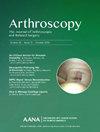接受关节镜下肩袖修复术的 II 型糖尿病患者使用塞马鲁肽可降低术后并发症和肩袖再撕裂的风险。
IF 4.4
1区 医学
Q1 ORTHOPEDICS
Arthroscopy-The Journal of Arthroscopic and Related Surgery
Pub Date : 2025-02-01
DOI:10.1016/j.arthro.2024.09.057
引用次数: 0
摘要
目的:研究 II 型糖尿病(T2DM)患者在接受关节镜下肩袖修复术(ARCR)后,术前使用塞马鲁肽(Ozempic® 和 Wegovy® 的活性剂)对术后九十天疗效和两年肩袖再撕裂的潜在影响:方法:使用管理账单代码从PearlDiver数据库中确定接受初级ARCR的T2DM患者。排除标准包括:患者:匹配后,符合纳入标准的 ARCR (+)semaglutide 患者有 1,094 人,ARCR (-)semaglutide 患者有 4,110 人。ARCR (-)semaglutide 和 ARCR (+)semaglutide 患者的 AAE 发生率分别为 27.4% 和 11.0%,SAE 发生率分别为 10.5% 和 3.5%,MAE 发生率分别为 22.0% 和 8.5%(p 结论:ARCR (-)semaglutide 和 ARCR (+)semaglutide 患者的 AAE 发生率分别为 27.4% 和 11.0%,SAE 发生率分别为 10.5% 和 3.5%,MAE 发生率分别为 22.0% 和 8.5%:接受ARCR的T2DM患者术前使用semaglutide与90天轻微和严重不良事件发生率降低以及2年肩袖再撕裂率降低有关:证据级别:III级,回顾性比较研究。本文章由计算机程序翻译,如有差异,请以英文原文为准。
Lower Risk of Postoperative Complications and Rotator Cuff Retear Associated With Semaglutide Use in Patients with Type II Diabetes Mellitus Undergoing Arthroscopic Rotator Cuff Repair
Purpose
To investigate the potential impact of preoperative semaglutide use (the active agent in Ozempic and Wegovy) on 90-day postoperative outcomes and 2-year rotator cuff retear after arthroscopic rotator cuff repair (ARCR) in patients with type II diabetes mellitus (T2DM).
Methods
Patients with T2DM undergoing primary ARCR were identified from the PearlDiver database using administrative billing codes. Exclusion criteria included patients <18 years old; previous RCR; concurrent nonrotator cuff−related arthroscopic shoulder procedures; any traumatic, neoplastic, or infectious diagnoses within 90 days before surgery; and <90-days follow-up. Patients with T2DM using semaglutide within 1 year of ARCR ([+]semaglutide) were matched 1:4 with patients with T2DM who did not ([−]semaglutide) by age, sex, Elixhauser Comorbidity Index, diabetes complications, obesity, tobacco, insulin, and metformin use. Occurrence of any adverse events (AAE), severe adverse events (SAE), and minor adverse events (MAE) within 90 days were compared by multivariable logistic regression. The 2-year retear was assessed by Kaplan-Meier survival analysis and compared by log-rank test.
Results
There were 1,094 ARCR (+)semaglutide and 4,110 ARCR (−)semaglutide patients meeting inclusion criteria after matching. The incidence of AAE for the ARCR (−)semaglutide versus ARCR (+)semaglutide patients was 27.4% versus 11.0%, SAE was 10.5% versus 3.5%, and MAE was 22.0% versus 8.5%, respectively (P < .001 for all). ARCR (−)semaglutide patients had a greater odds ratio of AAE (3.65, P < .001) and SAE (3.62, P < .001), including surgical-site infection (2.22, P = .049), venous thromboembolism (3.10, P < .001), sepsis (3.87, P < .001), and cardiac events (3.96, P < .001), as well as greater odds of MAE (3.59, P < .001), including urinary tract infection (3.27), pneumonia (3.88), acute kidney injury (3.91), and emergency department visits (2.51) (P < .001 for all). In addition, (−)semaglutide patients revealed greater 2-year retear vs (+)semaglutide patients (18.3% vs 12.5%, respectively) (P < .001).
Conclusions
Preoperative semaglutide use for patients with T2DM undergoing ARCR was associated with decreased odds of minor and serious 90-day adverse events and lower 2-year rotator cuff retear.
Level of Evidence
Level III, retrospective comparative study.
求助全文
通过发布文献求助,成功后即可免费获取论文全文。
去求助
来源期刊
CiteScore
9.30
自引率
17.00%
发文量
555
审稿时长
58 days
期刊介绍:
Nowhere is minimally invasive surgery explained better than in Arthroscopy, the leading peer-reviewed journal in the field. Every issue enables you to put into perspective the usefulness of the various emerging arthroscopic techniques. The advantages and disadvantages of these methods -- along with their applications in various situations -- are discussed in relation to their efficiency, efficacy and cost benefit. As a special incentive, paid subscribers also receive access to the journal expanded website.

 求助内容:
求助内容: 应助结果提醒方式:
应助结果提醒方式:


